
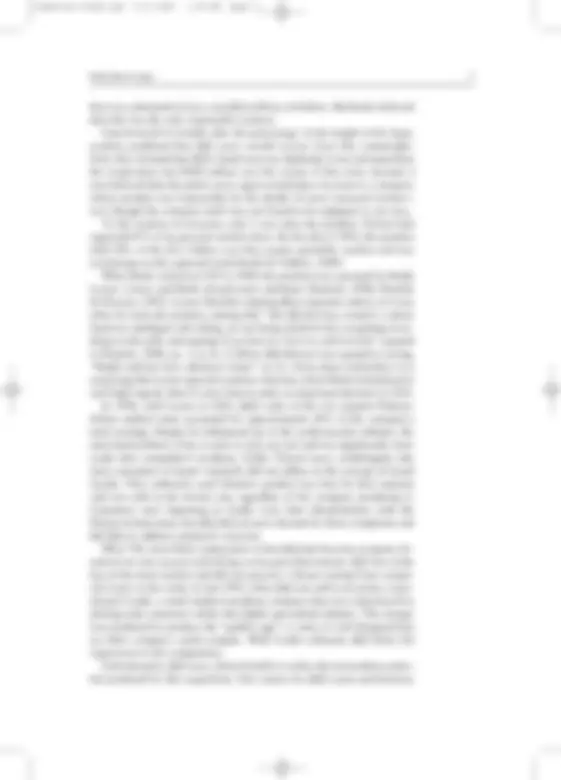
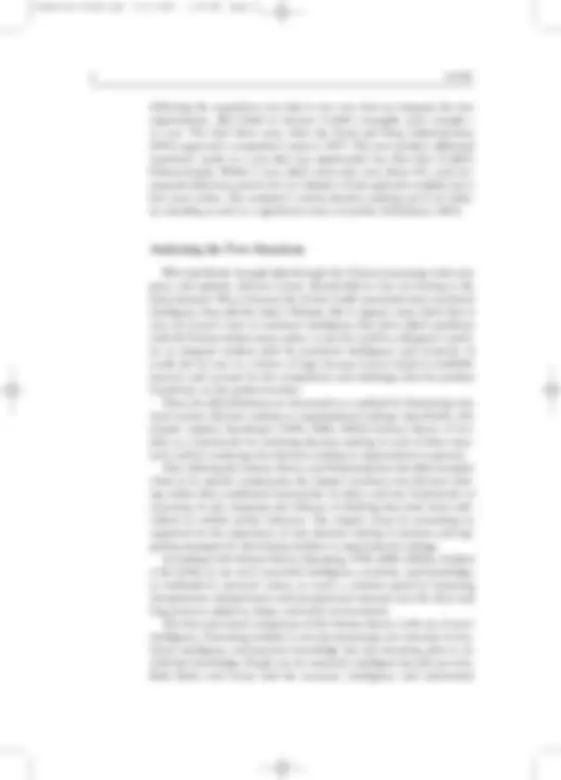
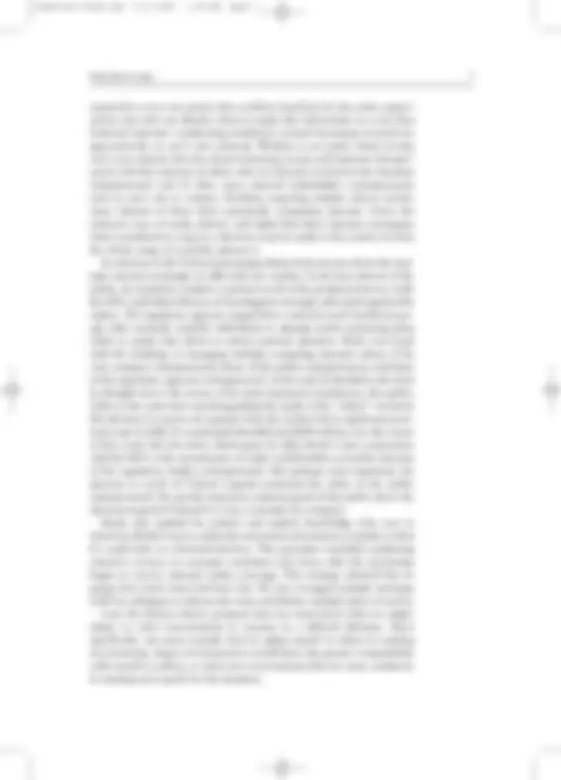
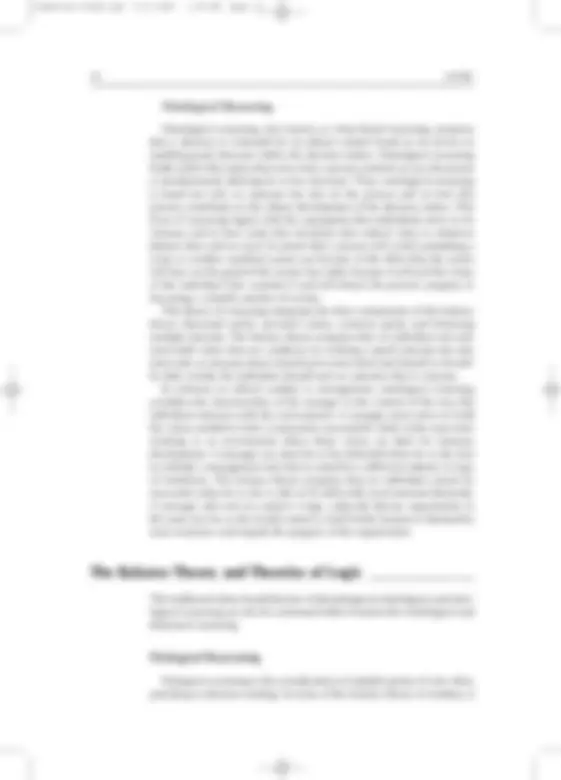
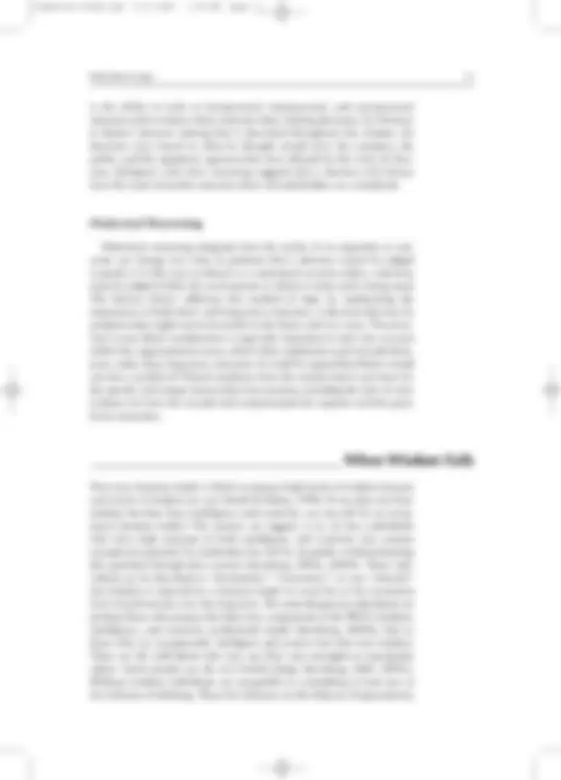
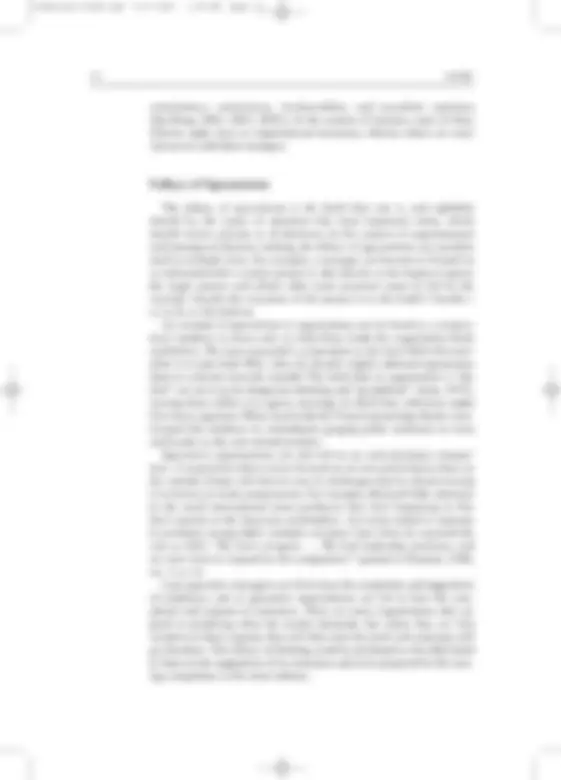
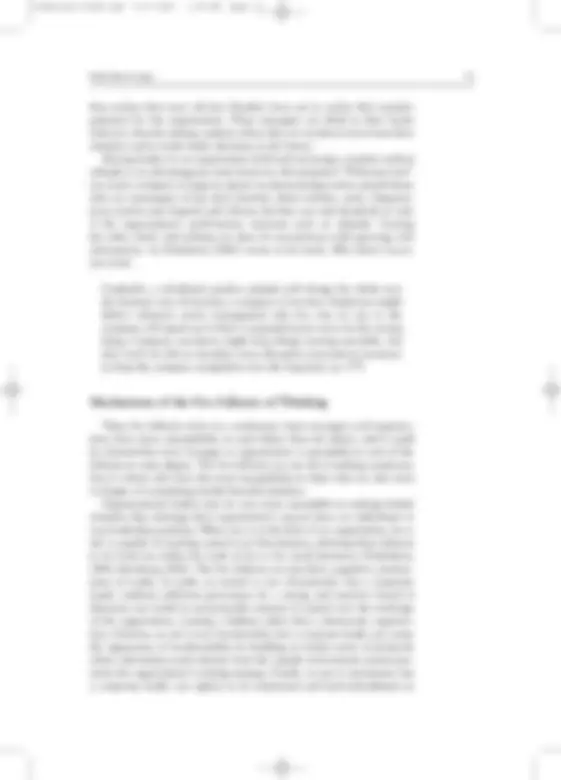
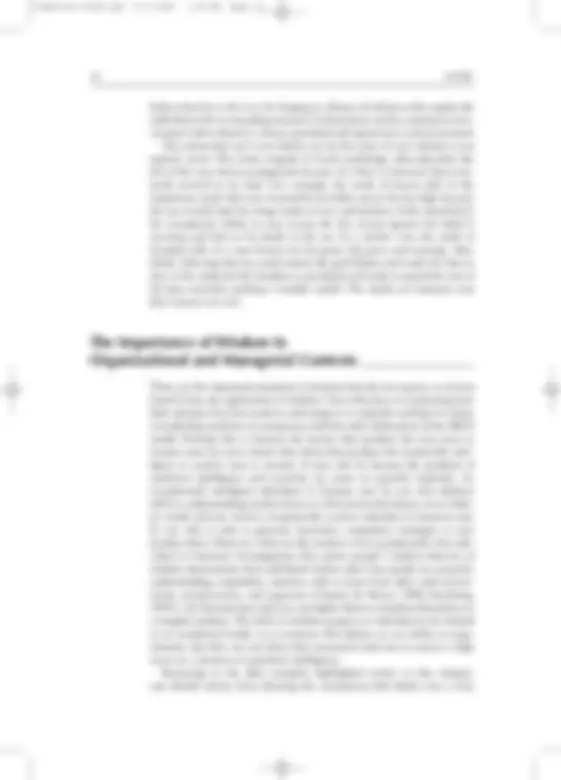
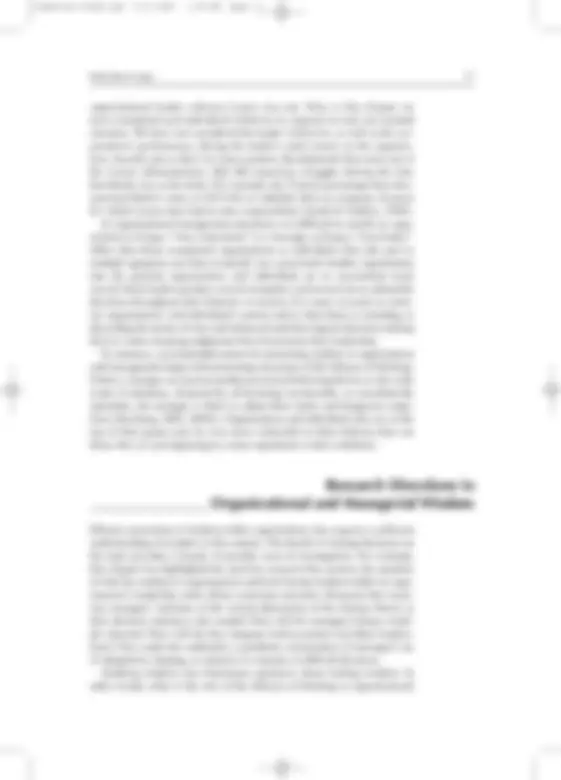



Study with the several resources on Docsity

Earn points by helping other students or get them with a premium plan


Prepare for your exams
Study with the several resources on Docsity

Earn points to download
Earn points by helping other students or get them with a premium plan
Community
Ask the community for help and clear up your study doubts
Discover the best universities in your country according to Docsity users
Free resources
Download our free guides on studying techniques, anxiety management strategies, and thesis advice from Docsity tutors
In this study, two anecdotes both about crucial decisionmaking situations at the J&J corporation.
Typology: Study Guides, Projects, Research
1 / 18

This page cannot be seen from the preview
Don't miss anything!











I
t could be argued that the most important factor in an organization’s suc- cess is wisdom, particularly the wisdom of those within the organization’s leadership ranks. An organization, whether it is a corporation, a government agency, or an academic institution, can go from being at the top of its game in an industry to struggling to scrape by—based solely on who is at the helm and this leader’s ability to impart wise leadership on the organization. Similarly, but perhaps less drastic, an organization can make one wise deci- sion followed by a less wise one based on how well its leaders are able to integrate the organization’s values and prudently use the resources it has been allotted when making decisions. Johnson & Johnson (J&J) presents an example of this contrast. Logic can be used as a basis for wisdom. Wisdom, as defined in this chapter (Sternberg, 1998, 2000, 2005b), involves an individual’s ability to balance the interests of multiple constituencies in a manner that serves each constituency’s needs and well-being over the long and short terms. To
3
AUTHORS’ NOTE: Preparation of this chapter was supported by Contract MDA 903-92-K- from the U.S. Army Research Institute and by Grant Award 31-1992-701 from the U.S. Department of Education, Institute for Educational Sciences, as administered by the Temple University Laboratory for Student Success. Grantees undertaking such projects are encouraged to express their professional judgment freely. This chapter, therefore, does not necessarily represent the position or policies of the U.S. Army Research Institute or the U.S. Department of Education, and no official endorsement should be inferred.
balance these interests, the information that the decision maker uses must be based in truth and logic. Without logic, it is impossible to be wise. In addition to examining what wisdom is, this chapter examines factors that can lead wisdom (and thus truth) to be lost or obscured in organizational and managerial contexts. We label these factors fallacies of thinking (Sternberg, 2002, 2003, 2005a), but they could just as well be considered fallacies of informal logic because of their direct and negative effects on the process of obtaining a logical outcome. In this chapter, we use two anecdotes—both about crucial decision- making situations at the J&J corporation. These anecdotes are used to illus- trate contrasting examples of wise and not-so-wise decision making within an organizational context. We then move from the examples into theory and describe the balance theory of wisdom (Sternberg, 1998, 2005a) and a related theory of foolishness (Sternberg, 2002, 2003).
Founded in 1886 as a medical products company, J&J quickly defined itself as one of the most brilliantly managed and innovative pharmaceutical and medical supply companies in the world. In 1976, James Burke, the former vice president of product management, ascended the ranks and became J&J’s chief executive officer (CEO). By 1981, the corporation was ranked 74th among the largest U.S. industrials. One of J&J’s best-selling products during the early 1970s and 1980s was Tylenol. In 1974, this prod- uct accounted for 90% of the nearly $88 million market in acetaminophen- based, over-the-counter painkillers. By 1981, J&J’s sales revenue from all Tylenol products was estimated at more than $400 million. This success was quickly put in jeopardy when, in the fall of 1982, four individuals died from ingesting cyanide-tainted Extra-Strength Tylenol capsules produced at J&J’s Pennsylvania plant. Three other individuals later died from tainted capsules produced at other plants. Burke’s swift and responsible actions were credited for J&J’s victorious emergence from this crisis. Specifically, Burke took two actions that came to be considered crucial in the resolution of this tragic situation. The first is that he and his colleagues were completely candid and forthright with the media. They did not try to sidestep the crucial and sometimes unflattering questions that were posed to them, and they did what they could to inform the public of any danger. The organizational leaders took these actions despite the fact that there was no evidence that any of the contamination took place either at a J&J plant or during the shipping process. The second crucial action was that J&J made sweeping actions for the purpose of protecting the public. In light of pressures from regulatory agen- cies to do otherwise, Burke decided to pull all Tylenol capsules from the market and offered to exchange all capsule products for tablets, a decision
4 LOGIC
following the acquisition was that it was very slow to integrate the two organizations. J&J failed to harness Cordis’s strengths early enough— or ever. The final blow came when the Food and Drug Administration (FDA) approved a competitor’s stent in 1997. This new product addressed customers’ needs at a cost that was significantly less than that of J&J’s Palmaz–Schatz. Within 1 year, J&J’s stent sales were down 8%, and con- sequently J&J lost control over an industry it had captured so tightly just a few years earlier. The company’s unwise decision making cost it its indus- try standing as well as a significant source of profits (Finkelstein, 2003).
Why had Burke brought J&J through the Tylenol poisonings with such grace and aplomb, whereas Larsen allowed J&J to lose its footing in the stent business? Was it because the former leader possessed more analytical intelligence than did the latter? Perhaps. But it appears more likely that it was not Larsen’s lack of analytical intelligence that led to J&J’s problems with the Palmaz–Schatz stent; rather, it was his (and his colleagues’) inabil- ity to integrate wisdom with his analytical intelligence and creativity. It could also be seen as a failure of logic because Larsen failed to truthfully perceive and account for the competition and challenges that his product would face on the medical market. These two J&J dilemmas are harnessed as a method for illustrating wise (and unwise) decision making in organizational settings. Specifically, this chapter employs Sternberg’s (1998, 2000, 2005b) balance theory of wis- dom as a framework for analyzing decision making in each of these situa- tions and for analyzing wise decision making in organizations in general. After defining the balance theory and illustrating how the J&J examples relate to its specific components, the chapter examines wise decision mak- ing within three traditional frameworks of ethics and two frameworks of reasoning. It also integrates the fallacies of thinking that lead smart indi- viduals to exhibit unwise behavior. The chapter closes by presenting an argument for the importance of wise decision making in business and sug- gesting strategies for developing wisdom in organizational settings. According to the balance theory (Sternberg, 1998, 2000, 2005b), wisdom is the ability to use one’s successful intelligence, creativity, and knowledge, as mediated by personal values, to reach a common good by balancing intrapersonal, interpersonal, and extrapersonal interests over the short and long terms to adapt to, shape, and select environments. The first and central component of the balance theory is the use of one’s intelligence. Possessing wisdom is not just possessing vast amounts of ana- lytical intelligence and practical knowledge but also knowing what to do with that knowledge. People can be extremely intelligent but still not wise. Both Burke and Larsen had the necessary intelligence and information
6 LOGIC
required to carry out actions that could be beneficial for the entire organi- zation, but only one (Burke) chose to apply this information in a way that balanced interests—moderating tendencies toward becoming focused too egocentrically on one’s own interests. Wisdom is not solely about serving one’s own interest but also about balancing various self-interests (intraper- sonal) with the interests of others who are directly involved in the situation (interpersonal) and of other more external stakeholders (extrapersonal) such as one’s city or country. Problems requiring wisdom always involve some element of these three potentially competing interests. Given the extensive area of needs, desires, and rights that these interests encompass when considered in concert, a decision must be made in the context of what the whole range of available options is. In reference to the Tylenol poisonings, Burke had concerns about the mul- tiple interests seemingly at odds with one another. In the best interest of the public, he wanted to conduct a national recall of the product; however, both the FDA and Federal Bureau of Investigation strongly advocated against this option. The regulatory agencies argued that a national recall would encour- age other mentally unstable individuals to attempt similar poisoning plots solely to satisfy their desire to attract national attention. Burke was faced with the challenge of managing multiple competing interests—those of his own company (intrapersonal), those of the public (interpersonal), and those of the regulatory agencies (extrapersonal). In the end, he decided to do what he thought was in the service of his most important constituency, the public, while at the same time not disregarding the needs of the “others” involved. His decision to remove all capsules from the market led to significant prox- imal costs for J&J (it is estimated that J&J lost $100 million over the course of this crisis) but also led to distal gains for J&J. Burke’s later cooperation with the FDA in the manufacture of safety-sealed bottles served the interests of the regulatory bodies (extrapersonal). But perhaps most important, his decision to recall all Tylenol capsules protected the safety of the public (interpersonal). He put the long-term common good of the public above the short-term good of himself or even, it seemed, his company. Burke also applied his explicit and implicit knowledge. One way in which he did this was to collect the maximum information available so that he could make an informed decision. This procedure included conducting extensive surveys on consumer sentiment only hours after the poisonings began to receive national media coverage. This strategy allowed him to gauge how much trust had been lost. He also arranged multiple meetings with his colleagues to discuss the issue and debate multiple plans of action. Last, the balance theory proposes that one must know when to adapt, shape, or select environments in reaction to a difficult dilemma. More specifically, one must consider how to adapt oneself or others to existing environments, shape environments to mold them into greater compatibility with oneself or others, or select new environments that are more conducive to meeting one’s goals for the situation.
Individual Logic 7
Within the organizational domain, the application of personal values when making a decision that affects the entire organization is a contro- versial issue. It is questionable whether a manager has the right to apply his or her personal values to decisions that have consequences for the organization as a whole. For example, an upper level manager may con- front the question of whether or not to allow same-sex partners to receive healthcare benefits similar to those given to opposite-sex spouses. In such a situation, should the manager allow his or her own beliefs about same- sex marriage to enter into the decision-making process? In the context of the balance theory, the answer is yes —with some qualifications. To par- take in wise decision making, the manager must allow these personal val- ues to enter into the process so long as the ultimate decision balances the interests of the multiple parties involved. These multiple interests must also include extrapersonal interests, which include the interests of the corporate community. For a manager’s decision to qualify as wise, the manager would need to consider how his or her interests would set a precedent for the entire industry.
Teleological Reasoning
A form of consequentialist reasoning, teleological reasoning, states that an action should be judged as ethical based on the good that is derived from its outcome. The ethicality of a result is calculated by weighing the benefits that come from the decision in comparison with the costs that it consumes. The utilitarian theory of ethics, one of the most widely applied theories of ethics in business, is considered to be under the rubric of teleological rea- soning. Utilitarianism proposes that any act should not be undertaken if it consumes greater good than it produces. The balance theory captures this same spirit of balance by incorporat- ing the common good into the decision-making process. For a decision to be considered wise, it must first pass a common good litmus test; that is, does it collectively benefit all stakeholders rather than just serving a few isolated interests? In application to the business domain, the issue of a common good is particularly salient. Often a leader’s downfall is witnessed in his or her focus on one or a few isolated parties at the enormous expense of other parties. For example, a manager may decide to expand a currently well- functioning business into a new industry—one in which the organization has little history or expertise. The venture can lead the company to sacri- fice its strong reputation and value to shareholders and may even cause the organization to need to lay off a significant percentage of the current workforce to support the costs of the poor decision. Such a decision would not be considered ethical by the standards of teleological reason- ing, or wise by the standards of the balance theory, because it was not undertaken with an understanding of how a balance could be achieved from the decision’s outcome.
Individual Logic 9
Ontological Reasoning
Ontological reasoning, also known as virtue-based reasoning, proposes that a decision is evaluated for its ethical content based on its service to instilling good character within the decision maker. Ontological reasoning holds central the notion that every time a person commits an act, the person is simultaneously defining his or her character. Thus, ontological reasoning is based not only on outcome but also on the process and on how this process contributes to the ethical development of the decision maker. This form of reasoning begins with the assumption that individuals strive to be virtuous and to have traits that maximize their ethical value in whatever domain they seek to excel. It asserts that a person will avoid committing a crime or another unethical action not because of the effect that the action will have on the good of the society but rather because it will soil the virtue of the individual who commits it and will thwart the person’s progress in becoming a valuable member of society. This theory of reasoning integrates the three components of the balance theory discussed earlier: personal values, common good, and balancing multiple interests. The balance theory proposes that an individual not only must hold values that are conducive to realizing a good outcome but also must seek an outcome that is beneficial to more than just himself or herself. In other words, the individual should seek an outcome that is virtuous. In reference to ethical conduct in management, ontological reasoning considers the characteristics of the manager in the context of the way this individual interacts with the environment. A manager must strive to hold the values needed to lead a corporation successfully while at the same time working in an environment where those values are ideal for business development. A manager can meet his or her downfall when he or she tries to embody a management style that is suited for a different industry or type of workforce. The balance theory proposes that an individual cannot be successful unless he or she is able to fit skills with environmental demands. A manager who tries to control a large, culturally diverse organization in the same way he or she would control a small family business is destined to meet resistance and impede the progress of the organization.
The traditional ethics-based theories of deontological, teleological, and onto- logical reasoning can also be contrasted within frameworks of dialogical and dialectical reasoning.
Dialogical reasoning is the consideration of multiple points of view when partaking in decision making. In terms of the balance theory of wisdom, it
10 LOGIC
omnipotence, omniscience, invulnerability, and unrealistic optimism (Sternberg, 2002, 2003, 2005a). In the context of business, some of these fallacies apply more to organizational structures, whereas others are more relevant to individual managers.
The fallacy of egocentrism is the belief that one is, and rightfully should be, the center of attention—the most important entity, which should receive priority in all decisions. In the context of organizational and managerial decision making, the fallacy of egocentrism can manifest itself in multiple ways. For example, a manager can become so fixated on or infatuated with a certain project or idea that he or she begins to ignore the larger picture and allows other more practical issues to fall by the wayside. Usually the execution of the project is to the leader’s benefit— or so he or she believes. An example of egocentrism in organizations can be found in a corpora- tion’s tendency to focus only on what those inside the organization think and believe. The more successful a corporation is, the more likely this men- tality is to take hold. Why, after all, should a highly admired organization listen to criticism from the outside? The belief that an organization is “the best” can set it up for dangerous thinking and “groupthink” (Janis, 1972), causing those within it to ignore warnings of which they otherwise might have been cognizant. When faced with the Tylenol poisonings, Burke coun- teracted this tendency by immediately gauging public sentiment on trust and loyalty to the now tainted product. Egocentric organizations can also fail to see and anticipate competi- tion. A corporation that is more focused on its own performance than on the outside climate will shut its eyes to challenges that lie ahead, leaving it no leeway to make preparations. For example, J&J paid little attention to the small international stent producers that were beginning to flex their muscles in the American marketplace. As Larsen stated in response to problems among J&J’s multiple consumer lines when he assumed the role as CEO, “We were arrogant.... We had leadership positions, and we were slow to respond to the competition” (quoted in Deutsch, 1988, sec. 1, p. 6). Last, egocentric managers can fail to hear the complaints and suggestions of employees, just as egocentric organizations can fail to hear the com- plaints and requests of customers. There are many organizations that are good at producing what the market demands, but unless they are first receptive to these requests, they will often miss the mark and customers will go elsewhere. This fallacy of thinking could be attributed to why J&J failed to listen to the suggestions of its customers and to be prepared for the ensu- ing competition in the stent industry.
12 LOGIC
The fallacy of omnipotence is the belief that one is all-powerful—able to direct others to follow one’s every whim and wish. In the organizational context, this fallacy can manifest itself in the belief that the organization is capable of manipulating random or uncontrollable factors to work in its favor or in a leader’s belief that he or she can direct outcomes of situations that are, in reality, determined by the confluence of many external factors beyond his or her control. This fallacy can also manifest itself in a manager’s attitude within the workplace. One of the most dangerous behaviors that can stymie wise deci- sion making is a leader’s portrayal that he or she is so powerful that follow- ers are discouraged from voicing any open dissent. Wise decision making is based on a balanced presentation of the situation and the multiple interests involved. If a leader acts as though he or she is all-powerful, other perspec- tives will never be acknowledged or presented. In reference to J&J’s problems in the stent industry, it is likely that the hierarchy of authority was so elabo- rate and confusing that customers’ complaints were never able to reach the level of management responsible for making changes to the stent’s design. We are not arguing that an organization should not strive to be at the top of its industry; rather, we are arguing that this should not be the organiza- tion’s explicit goal at the expense of responsibility to all stakeholders. This mind-set encourages organization personnel to adopt strategies that may focus only on short-term gain rather than on long-term sustained viability.
The fallacy of omniscience is the belief that one is all-knowing. A leader’s downfall can result from a false belief that he or she knows more than do others around him or her—particularly more than the leaders of other com- peting organizations. For example, a leader may believe that his or her organization is capable of surpassing other larger competitors, even though none of the objective factors seems to support this notion. An omniscient mind-set can also give birth to an unreceptive manner of logic and decision making. Managers who believe that they know everything will not listen to or solicit criticisms from inside or outside the organization. They will not admit to and learn from mistakes. Why? Because they believe that there is nothing they can learn from others. They will also not actively seek out information to help them improve their organization because they do not believe that they can learn from others’ successes or failures. When Burke was making his decision as to how to proceed with the Tylenol poisonings, he first arranged and participated in a series of discus- sions—sometimes heated—with his subordinates so that a variety of opin- ions would be presented and acknowledged.
Individual Logic 13
that actions that were obvious blunders have yet to realize their positive potential for the organization. These managers are blind to their faulty behavior, thereby setting a pattern where they are unable to learn from their mistakes and to make better decisions in the future. Having leaders in an organization hold and encourage a positive upbeat attitude is an advantageous asset; however, this perpetual “Pollyanna-ism” can lead a company to begin to ignore its shortcomings and to punish those who are messengers of less than cheerful, albeit realistic, news. Organiza- tions need to stay hopeful and vibrant, but they can and should do so only if the organization’s performance warrants such an attitude. Turning the other cheek and smiling can often be synonymous with ignoring vital information. As Finkelstein (2003) wrote in his book, Why Smart Execu- tives Fail,
Gradually, a relentlessly positive attitude will change the whole way the business runs. It becomes a company of yes-men. Employees might deliver whatever senior management asks for, but no one in the company will speak up if what is requested turns out to be the wrong thing. Company executives might keep things running smoothly, but they won’t be able to introduce more disruptive innovations necessary to keep the company competitive over the long haul. (p. 177)
These five fallacies exist on a continuum. Some managers and organiza- tions have more susceptibility to each fallacy than do others, and it could be claimed that every manager or organization is susceptible to each of the fallacies to some degree. The five fallacies are not all-or-nothing constructs, but it is those who have the most susceptibility to them who are also most in danger of committing foolish harmful mistakes. Organizational leaders may be even more susceptible to making foolish mistakes that sabotage their organization’s success than are individuals in non-leadership positions. When one is at the helm of an organization, he or she is capable of exerting control over that domain, allowing these fallacies to be lived out within the walls of his or her small dominion (Finkelstein, 2003; Sternberg, 2002). The five fallacies are just that—cognitive construc- tions of reality. In truth, no mortal is ever all-powerful, but a corporate leader (without sufficient governance by a strong and assertive board of directors) can wield an unreasonable amount of control over the workings of the organization, creating a fiefdom rather than a democratic organiza- tion. Likewise, no one is ever invulnerable, but a corporate leader can create the appearance of invulnerability by building an insular series of protocols where information and criticism from the outside environment cannot pen- etrate the organization’s existing strategy. Finally, no one is omniscient, but a corporate leader can appear to be omniscient and lead subordinates to
Individual Logic 15
believe that he or she is so by forging an alliance of advisers who supply the individual with an unending amount of information and by creating an envi- ronment where dissent is always punished and agreement is always praised. The notion that one’s own hubris can be the cause of one’s demise is not entirely novel. The classic tragedy in Greek mythology often describes the fall of the once heroic protagonist because of a flaw in character that even- tually proved to be fatal. For example, the myth of Icarus tells of the impetuous youth who was warned by his father not to fly too high because the sun would melt his wings made of wax and feathers. Fully absorbed in his exceptional ability to soar across the sky, Icarus ignores his father’s warning and falls to his death in the sea. In a similar vein, the myth of Sisyphus tells of a man known for his great chicanery and cunning. After falsely believing that he could outwit the god Hades and evade his fate to stay in the underworld, Sisyphus is punished and made to spend the rest of his days eternally pushing a boulder uphill. The myths are fantasies, but their lessons are real.
There are few important situations in business that do not require, or at least benefit from, the application of wisdom. Given this fact, it is surprising how little attention has been paid to cultivating it or explicitly seeking it in those in leadership positions in comparison with the other dimensions of the WICS model. Perhaps this is because the factors that produce the wise man or woman seem far more elusive than those that produce the analytically intel- ligent or creative man or woman. It may also be because the products of analytical intelligence and creativity are easier to quantify explicitly. An exceptionally intelligent individual in business may be one who displays skills in understanding market forces or who knows the history of an indus- try inside and out. And an exceptionally creative individual in business may be one who is able to generate innovative competitive strategies or new product ideas. However, what are the markers of an exceptionally wise indi- vidual in business? Investigations that report people’s implicit theories of wisdom demonstrate that individuals believe that wise people are peaceful, understanding, empathetic, intuitive, able to learn from ideas and environ- ments, perspicacious, and sagacious (Clayton & Birren, 1980; Sternberg, 1985)—all characteristics that are not highly likely to manifest themselves in a tangible product. The skills of wisdom prepare an individual to be labeled as an exceptional leader or as someone who defines an era within an orga- nization, but they are not those that necessarily lead one to receive a high score on a measure of analytical intelligence. Returning to the J&J examples highlighted earlier in this chapter, one should refrain from drawing the conclusions that Burke was a wise
16 LOGIC
and managerial situations? A scale that measures a person’s susceptibility to these fallacies already exists (Jordan, 2005); however, the fallacies’ impli- cations for decisions in organizational settings have yet to be examined.
How does one develop wisdom for organizational settings? Ideally, wisdom- related skills would be developed in undergraduate and graduate business programs. They would also be developed through job-related experience. Here are some principles for developing wisdom in managerial settings:
In sum, then, wise decision making can be developed. We have a way. We need only the will.
18 LOGIC
Clayton, V. P., & Birren, J. E. (1980). The development of wisdom across the life- span: A reexamination of an ancient topic. In P. B. Baltes & O. G. Brim, Jr. (Eds.), Lifespan development and behavior (pp. 103–135). New York: Academic Press. Deutsch, C. H. (1988, October 30). Taking the reins from a legend. New York Times, sec. 1, p. 6. Finkelstein, S. (2003). Why smart executives fail. New York: Portfolio Press. Hurstak, J. M., & Pearson, A. E. (1992). Johnson & Johnson in the 1990s. Boston: Harvard Business School Press. Janis, I. L. (1972). Groupthink. Boston: Houghton Mifflin. Jordan, J. (2005). Business experience and moral awareness: When less may be more. Unpublished doctoral dissertation, Yale University. Newton, L. H., & Schmidt, D. P. (2004). Wake-up calls: Classic cases in business ethics. Cincinnati, OH: Thomson South-Western. Smith, J., & Baltes, P. B. (1990). Wisdom related knowledge: Age/cohort difference in response to life-planning problems. Developmental Psychology, 26, 494–505. Smith, W. K., & Tedlow, R. S. (1989). James Burke: A career in American business (A/B). Boston: Harvard Business School Press. Sternberg, R. J. (1985). Implicit theories of intelligence, creativity, and wisdom. Journal of Personality and Social Psychology, 49, 607–627. Sternberg, R. J. (1998). A balance theory of wisdom. Review of General Psychology, 2, 347–365. Sternberg, R. J. (2000). Creativity is a decision. In B. Z. Presseisen (Ed.), Teaching for intelligence: II. A collection of articles (pp. 83–103). Arlington Heights, IL: Skylight Training and Publishing. Sternberg, R. J. (2002). Smart people are not stupid, but they sure can be foolish: The imbalance theory of foolishness. In R. J. Sternberg (Ed.), Why smart people can be so stupid (pp. 232–242). New Haven, CT: Yale University Press. Sternberg, R. J. (2003). WICS: A model of leadership in organizations. Academy of Management: Learning and Education, 2, 386–401. Sternberg, R. J. (2005a). Foolishness. In R. J. Sternberg & J. Jordan (Eds.), Handbook of wisdom: Psychological perspectives (pp. 331–352). New York: Cambridge University Press. Sternberg, R. J. (2005b). WICS: A model of positive educational leadership compris- ing wisdom, intelligence, and creativity synthesized. Educational Psychology Review, 17, 191–262.
Individual Logic 19